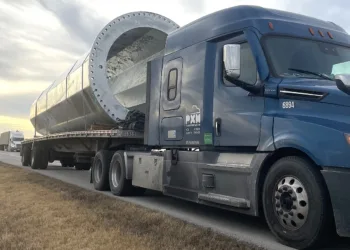 C
C
argo-carrying capacity in the China-owned fleet of merchant ships – bulk carriers, tankers, container ships, gas carriers and other ship types – continued to grow strongly in recent years. A large volume of newbuildings on order points to further expansion.
Over the past decade this fleet, now the largest among owning countries based on one tonnage measurement, has been growing at well over twice the rate of the world fleet as a whole. The capacity added enables rising shares of seaborne imports to and exports from China to be carried in nationally-owned vessels.
An aim of government transport policy to reduce dependence on foreign shipowners has been fulfilled. Involvement in open market ‘cross-trades’ where China is neither importer nor exporter is also assisted by the enlarging fleet.
Strong enlargement trend
Based on gross tonnes as a common measurement for all vessel types, the China-owned merchant ship fleet now comprises about one-sixth of the world total, compared with around one-twentieth in the early 2000s. All categories have seen rapid growth in recent years.
Capacity in the China-owned fleet doubled during the past decade. According to data compiled by Clarksons Research the total at the end of 2013 was 125.0 million gross tonnes, rising to 258.4m gt at end-2023. This 107 percent increase resulted from an annual average 7.6 percent growth rate. The bulk carrier fleet remains the largest component, currently contributing just over half.
Annual growth in capacity results from the interaction of four main elements. Newbuilding deliveries and secondhand vessel purchases add capacity, while second-hand sales and scrapping (recycling) reduce it. Fleet growth rates reflect changes in, and the relationship among these influences.
Although variations in annual increases in the China-owned merchant ship fleet have been a feature, since 2014 greater stability of growth rates has evolved. In this period, growth in six of the years from 2015 to 2023 was between 5.0 and 7.8 percent, accompanied by two years (2021 and 2017) at 9.3 and 9.6 percent respectively, and one exceptionally rapid growth year (2018) at 13.9 percent. During the nine years 2015 to 2023 as a whole, growth averaged 8.1 percent annually, more than twice the world fleet’s average 3.4 percent annual expansion.
China-owned merchant ship fleet enlargement during the past nine years totalled 129.6m gt. The fleet grew from 128.8m gt at end-2014, to 258.4m gt at the end of 2023. Almost half the overall fleet expansion during the period was comprised of bulk carriers, including ore carriers (46 percent of the total increase). About one quarter was container ships (26 percent), followed by tankers (17 percent) and other vessel types (11 percent).
Comparing average growth rates in the main vessel type groups over the past five years, 2019 to 2023, some notable similarities are evident. Although annual growth varied widely, both within each type group, and across groups in individual years, averages in the five years period were fairly uniform. Bulk carriers grew by an average 7.7 percent, tankers by 6.2 percent, container ships by 5.9 percent and other types by 6.3 percent.
Fleet growth in 2023
Data for the most recent full year reveals some significant changes among the categories, based on the Clarksons Research figures. In 2023 annual growth of 6.5 percent in the China-owned merchant ship fleet was greatly boosted by container ship capacity expanding by 19 percent from the previous year. Within the entire fleet’s 15.8m gt growth, additional container ship capacity contributed 7.6m gt or 48 percent. The bulk carrier fleet contributed 4.6m gt or 29 percent.
Increased newbuilding deliveries during 2023 strengthened fleet expansion. In the merchant fleet as a whole new ships delivered totalled 16.8m gt, a 26 percent rise from the preceding twelve months, reflecting higher ordering patterns in the previous period. Purchases of secondhand vessels from foreign shipowners last year were down by about 4 percent at 10.8m gt, while sales to foreign owners were 18 percent higher at 9.3m gt. The effect of these two changes was a net 1.5m gt addition to the fleet. Scrapping (recycling) of old or obsolete tonnage remained very low at 1.5m gt, representing less than one percent of the start-of-year fleet capacity, although this volume was more than double the previous year’s minimal volume.
Variations in these influences during recent years illustrate how the impact of new ship capacity entering the China-owned fleet is often modified by several other changes. Last year newbuilding deliveries and secondhand ship purchases were substantially offset by secondhand sales plus sales for scrapping.
How will the future fleet evolve?
Several elements of the China-owned merchant ship fleet’s future progress are difficult to assess. It seems realistic to expect that unusually low scrapping volumes seen in recent years are likely to increase. But estimates of secondhand ship purchases and sales are largely speculative guesses about unknown strategy and intentions that may change over time.
Some indications of prospects for the future fleet may be derived from the delivery schedule for newbuilding vessels based on confirmed orders placed at shipbuilding yards. The delivery schedule is not always a totally reliable indicator of future volumes and timing of capacity additions, although it is often a useful approximation. A newbuilding’s delivery timing sometimes changes, compared with the schedule, due to delay or postponement. Cancellations, or orders changed to another ship type, typically are fairly minor features.
A strong trend in newbuilding orders placed by shipowners based in China has unfolded over the past few years. This trend resulted in an expanding orderbook, as deliveries of ships previously contracted were outpaced by the incoming volume of new orders. After declining for several years up to end-2019 when it totalled 18.8m gt, the orderbook has risen rapidly, reaching 35.7m gt by the end of 2023, a 90 percent increase over four years.
The end-2023 orderbook was equivalent to almost 14 percent of the existing China-owned merchant ship fleet’s capacity. Within this total, as calculated at the end of last year, 14.1m gt was scheduled for delivery during 2024, implying a downturn of about 16 percent compared with last year’s actual deliveries. In 2025 a further 10.8m gt was scheduled for delivery, a total that may be modified by additional orders placed or disclosure of unrecorded orders.
One question arising is whether the orders schedule recorded at the end of last year provides an accurate indication of actual deliveries in 2024 and 2025. For 2024, it can be assumed that the schedule shows an almost complete calculation of deliveries, although some may not have been recorded. Typically when any year begins there is limited time available for additional orders to be placed for delivery within the twelve months period. This constraint results from (a) insufficient time available to complete construction, or (b) shipbuilding yard berths (slots) unavailable for immediate completions due to existing orders being built. For 2025, further orders could be added but it seems clear that many shipyard order books are already fairly full.
Within the newbuilding orderbook (as at the end of 2023) for China-owned merchant ships, several notable categories of vessel are features. Large container ships in the 14-24,000 teu size group numbered 49 orders, including 22 scheduled for delivery in 2024 and 15 next year. Liquefied natural gas (LNG) carriers numbered 40 orders for the standard 174-175,000 cubic metres size, but only two were scheduled in 2024 and 10 in 2025, followed by the majority in later years. The liquefied petroleum gas (LPG) carriers group was comprised of 31 orders for 90-99,999 cbm size vessels, mainly scheduled for 2026 onwards.
A relatively small number of 12 large tankers of over 100,000 dwt ordered included 3 very large crude carriers (vlccs) of 300-309,999 dwt for delivery in 2025. By contrast bulk carrier orders are extensive. The end-2023 orderbook included 199 ultramax, panamax and kamsarmax vessels in the 60-89,999 dwt size group, of which 103 were scheduled for 2024 delivery and 63 in 2025. Another prominent category is large car carriers in the 7-10,000 ceu (car equivalent unit) size numbering 46, including 8 for delivery in 2024 and 25 next year. Also, orders for 25 multi-purpose ships of 62,000 dwt were recorded, including 4 scheduled for 2024 delivery.
Overview of fleet growth prospects
The large orderbook for China-owned newbuilding vessels, amounting to about one-seventh of existing capacity, points to further enlargement of the fleet over the years ahead. Another trend can be perceived as positively affecting fleet growth. China’s greater proportionate share of world seaborne trade (especially as an importer, with a quarter of the world total), than of the global merchant ship fleet implies an incentive to expand cargo-carrying capacity.
Partly the prospects for fleet growth depend on how Chinese leasing companies’ activities progress. These leasing companies, several of which now operate on a large scale, provide finance for foreign clients in numerous countries. Their services reflect demand for, and the supply of finance in the international shipping market, competing with many other financial houses. In recent years foreign ship operators have reacted to favourable finance terms offered by Chinese lessors.
As already discussed, growth in the China-owned fleet depends on the scale of changes in several elements. Augmenting the volume of newbuilding deliveries, in 2024 and further ahead the fleet’s development will reflect secondhand ship purchases, while also reflecting the offsetting impact of secondhand sales and recycling sales. Estimates of these changes are speculative, because many unpredictable influences affect decisions by owners about whether and how to acquire or dispose of tonnage.
Ideas about the China-owned merchant ship fleet’s future trend are based upon a few solid signs, coupled with broad assumptions and speculation. Continued expansion seems a plausible expectation. Official and unofficial narrative about intentions to reduce dependence on foreign-owned ships, emerging over a number of past years, has also reinforced this view.
Reflecting these perceptions, expansion of the China-owned fleet at a robust pace seems likely over the next several years at least. But as highlighted the evidence base is quite thin, and expectations tend to be affected by recent trends and observed characteristics. One possible outcome is that future merchant ship fleet expansion proves slower than the average rate seen in the past decade.
Source: Article arranged for Hellenic Shipping News Worldwide (www.hellenicshippingnews.com), By Richard Scott FICS, committee member, London & South-East Branch, Institute of Chartered Shipbrokers, contact details: [email protected]




















